Parkes-Goobang
Wayne leaves at dawn to give the mosquitoes an early breakfast, and at a more civilized hour I venture into the kitchen. It reminds me of grandmas kitchens everywhere: open shelves instead of cupboards, every horizontal space crammed with bottles, boxes, tubs and tubes. Most of them look very old, and many of them look very used. The dusky product of a less hygienic age, but a space where hard work and love have left a comfortable patina over everything.
I'm half way through making myself a cup of coffee when the manager comes in in her dressing gown and shuffles around doing the same. Turns out her daughter owns the place, and she and her boy-friend Steve (the barman) run it for her. We sit out in the back yard with her caged parrot and a young puppy who is systematically chewing up everything in the yard, including a potted palm and my toes. The palm is now lying sideways half out of its pot, and there are tell-tale paw prints in the spilt earth (as if we needed any clues). In between a running commentary with the bird, which she's trying to teach to talk, and constant threats on the life of the pup, she tells me her life story. Steve comes out with his coffee, in classic Aussie attire: short shorts and flip-flops. When necessary, this is topped with a t-shirt, but that isn't necessary here. Silently he lights up for both of them, and hands one to her.
When Wayne returns, we finish off bread, cheese and sausage for breakfast, and plan the day. There are no clear targets, so we agree on Parkes, which I've expressed a desire to see on previous occasions, and has the advantage of diverting us from the main highway. There appears to be a National Park nearby, so that gives us our two targets. The only thing we're not clear on is how to get out of town, since the map is too large a scale to pinpoint where the cross-country route leaves the main highway. I figure the landlady will not know how to get to Parkes (which is 100-plus miles from here) so we select the next town over on the route we want and ask about that.
"Can you tell us how to get to Buddabuddah?" (Which I pronounce as if it were a pair of gods.)
"You mean Budda-budd-AHH?"
"Sure"
"I only know how to pronounce it because my brother dated a girl from there once"
"You mean you've never been there?"
"Nope"
"Yikes, but you do know how to get there, right?" (Like most towns, Nyngan is a junction, but it ain't that complicated).
"Sure. Just head out on the Mitchell Highway and you'll see it on the right."
We head out of town on the Mitchell Highway but we don't see it on the right. The only thing worse than turning around is turning around, going back only to find you should have gone just a little further. So we go a long way out, but there's no turn. We head back into town, and stop someone on the street. We ask the same question.
"Yup, it's just down there on the left" (remember we're still pointing in the other direction).
"Is it signposted?"
"No worries"
Well there is a signpost, but BuddabuDDAH isn't on it. Tottenham is though, and it is also on the map, and it is on the right road. We turn left. After a while we come to Buddabuddah. We stop to photograph the now legendary spot. And legendary is the right word. No wonder the landlady hasn't visited. If we hadn't built it up into such a big deal, we'd have blown by it without noticing.
We move on. In the warmth of the spring day, the butterflies are out in force. They become more and more prolific until it seems like it is snowing butterflies. The windshield wipers and washer fluid can't keep up and a greasy film builds up until it gets quite hard to see. Finally Tottenham appears through the haze. Tottenham is a lovely little town, extremely well kempt and since it is now close to 10am, clearly the perfect spot to stop for a long black and meat pie lunch.
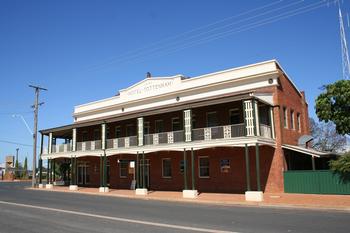 |
Wayne photographs the hotel while I visit Kay at the Tottenham Bakery. I step right back into my childhood. I recognize sticky buns that I swear I haven't seen in forty years. One stands out in particular. It is basically a bread roll (always disappointing to bite into) with a slit across the top into which is squirted a strip of whipped cream. A thin coating of white icing hides the crust that would otherwise give away that fact that it's just a bread roll, then a glacier cherry on top. There was also ginger beer in the cooler. I twist the top off a bottle and take a swig. Exactly as it should be, not too sweet. Delicious. |
 |
I don't see any coffee though. I ask Kay (when we were done I picked up a business card, which listed Ray and Kay Henry as the proprietors, and this was clearly Kay). She glances at the clock. It is before 11:00am when the cafe opens, so she's allowed to sell me two long blacks, which she brews for us on the spot. While she's picking out two meat pies, the post woman pulls up on her moped. "She's a lovely lady," Kay muses, half under her breath "but I do like it when she passes right by." |
|
 |
 |
|
Parkes
The Parkes Observatory is operated by the Australia Telescope National Facility, ATNF, a division of the Commonwealth Scientific and Industrial Research Organization, CSIRO.
It was one giant leap for mankind, and it was taken at 12.56 pm Australian Eastern Standard Time (AEST) on Monday 21 July 1969.
Six hundred million people, or one fifth of mankind at the time, watched Neil Armstrong's first steps on the Moon. Three tracking stations were receiving the signals simultaneously. They were CSIRO's Parkes Radio Telescope, the Honeysuckle Creek tracking station outside Canberra, and NASA's Goldstone station in California.
The signals were relayed to Mission Control at Houston. During the first few minutes of the broadcast, NASA alternated between the signals from its two stations at Goldstone and Honeysuckle Creek, searching for the best quality images. When they switched to the Parkes pictures, they were of such superior quality, that NASA remained with the Parkes TV pictures for the remainder of the 2.5-hour telecast.
Spotted Harrier (50-60cm)
Found through out the Australian mainland this raptor frequents grassland, farmland and swamplands. Hunts by flying low over areas in search of prey, eats small mammals, reptiles and ground birds.
Goobang National Park
This long strip of park protects the largest remnant forest and woodland in the central west, where western and coastal NSW flora and fauna species overlap. Eleven of the park's plant communities are considered rare or vulnerable. There are dry sclerophyll woodlands, white box woodland with grassy understorey, open heath land, and mallee species.
Native plants
A total of 459 native plant species have been recorded in the park, of which many are threatened plants and some are found only in the local area.
Because of the park's isolated location and scattered vegetation, native animal communities are often highly localized. A number of the fauna species are listed as either vulnerable or endangered. Animals and birds you may see include the koala, greater long-eared bat, yellow-bellied sheathtailed bat, regent honeyeater, glossy black cockatoo, superb parrot, and turquoise parrot. |
|
 | |
 |
|
The post woman walks in right in front of Wayne, hands a stack of bills to Kay and bids a cheery "G'day." Wayne sees the open bottle on the counter and takes a gulp. Then he checks the label, and pulls a second bottle out of the cooler. We pay for everything and return to the car. The butterfly carcasses are so thick on the front of the car that birds are hanging off the radiator grille to dine on the remains. Let's not mention the flies.
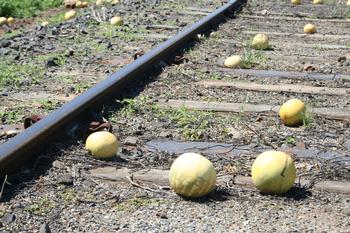 |
Soon after leaving town my notes show that we see our second-largest reptile: a three foot goanna with a yellow tail-band. We also stop twice near rail tracks, and both times find melons/squash growing right on the tracks. There's no sign of them more than 10 or 15 feet from the track, but the "patches run for 100 yards or more along the line. Most odd, not least because the actual vine in all cases is dead and dry already. Examining them takes us through some fairly tall grass, and I'm glad to get back to the road without disturbing any reptiles.
Then it is an event-free run into Parkes, where the Information office confirms what we'd guessed: "the dish" is 15 miles out of town. Better news is that there appears to be a short cut out of the back of the site to pick up the other road to Goobang National Park, and from there to Katoomba, our target for the night stop, which would leave us in easy striking range of Sydney the following morning. |
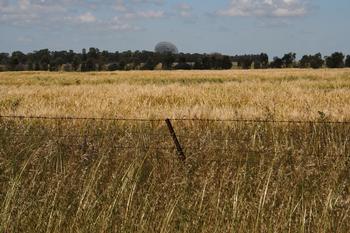 |
Sure enough, about 10 miles north we spot the dish above the tree line, and 15 miles out of town is a turn off. Soon after the turn we stop to take some pictures of the view across the wheat fields, and because we do we are treated to a spectacular display by a Spotted Harrier which floats alongside the car for several hundred yards and only 50 or 100 feet away. Bill says it has only about a two foot wingspan. It seemed twice that to me. Finally it gently wheels across in front of us and drifts on over the fields.
Thanks to the 2000 movie "The Dish" the radio telescope at Parkes has become a household name, at least in our household. The movie tells of the dramatic role that the dish played in relaying the live pictures of Armstrong's first steps on the moon. What is less well known is that Parkes also played a vital role at critical phases of the rescue effort for Apollo 13 by allowing the extremely weak telemetry signals from the command module Odyssey to be downlinked and the problems correctly diagnosed. |
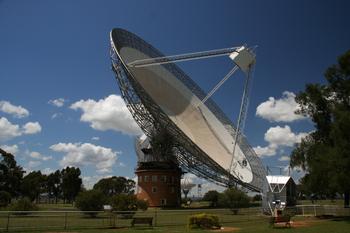 |
The only other fact I remember from the display speaks to the weakness of signal strength that the dish accommodates: in the space of a year (24x7x365) the dish collects enough energy to light a 100watt light bulb for 1,000,000th of a second. No, I'm not quite sure what that means either, but doesn't sound like a lot. |
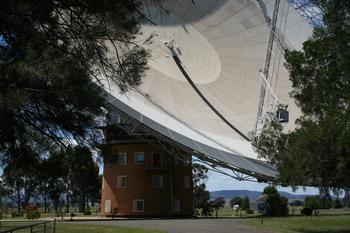 |
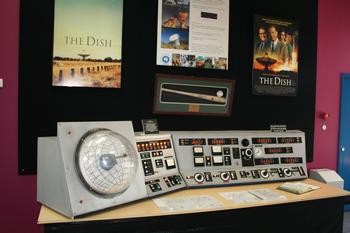 |
Having watched "The Dish" so often, I am extremely familiar with what it was supposed to look like, and it was a pleasant surprise to find it exactly as I imagined/remembered. Of course, there is a visitor center there now, but by standing in it, or in front of it, one can easily observe the actual radio telescope "standing in a sheep paddock" just as they claim in the movie. The visitors center has the usual tchotchkes, but also some of the movie's equipment props, and of course a great deal more history out on display than the 150 minutes that made it famous. There was also a restaurant where we persuaded the counter staff to sell us a couple of beers without any food. We didn't need the beer of course, but it was a great excuse to sit in the sunshine and just gaze at the view. And what a view. The dish is about 200 feet wide. And moves fast enough that we can watch (and hear it) as it is repositioned several times in the 20 minutes we sat there. A black falcon flew overhead, giving the galahs which had been taking a ride on the top something to squawk about. |
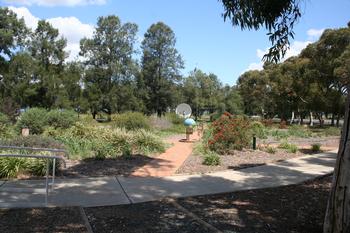 |
Finally in the gardens in front of the center are two dishes about 10 feet across, and 100 feet apart, facing each other. One is instructed to stand on the little plinth in front of the dish, facing it (and therefore facing away from the other dish). Meanwhile your buddy is to do the same at the other dish. When Wayne whispers into his dish, it sounds so close that I'm tempted to turn around to check that he isn't standing at my shoulder. It is an absolutely amazing display of the physical properties that the radio telescopes are exploiting. Truly excellent. Every school should have one.
We've been given more detailed instructions on the "back way out" by the cashier in the center. There are too many options and too few signposts, but we do eventually find ourselves on the right road. It takes a couple more miles to convince ourselves that it is indeed the right road, but we're heading in the wrong direction on it. |
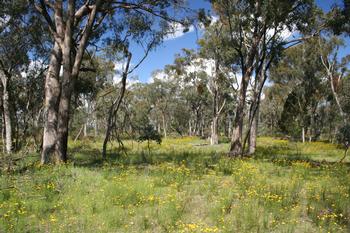 |
Goobang is an unassuming little park, at the least the couple of miles that we explore is. I think we saw more flora (wild flowers in bloom) than fauna (I saw one Sulphur-Crested Cockatoo, a couple of LBJs (little brown jobs) and one macropod, that's about it) but it was a pleasant enough interlude. |
 |
 |
We're clearly out of the outback and into a more familiar-feeling deciduous woodland. It even smells of wood instead of heat.
We've only been back in the car a couple of hundred yards when we stop for our next obstacle: a long-necked (Murray River?) turtle has nearly completed its crossing. By the time we've stopped and grabbed the cameras it has made it to the grass verge.
Wayne picks it up (it's about 9 inches across) and puts it back on the road so we can photograph it. Big mistake. Huge mistake. The smell it leaves on his hands would gag the proverbial maggot. And it will not come off. Wayne described it as smelling like onions and something foul, but that's only headed in the general direction, it doesn't really get close to the target. We dig out soap from a bag, and pour precious water over his hands. He washes them thoroughly, twice, but even I can still smell it. We drive with the windows open for a long while, trying to resist the temptation to put his hands outside, which we've been warned is illegal in Australia. |
We're still on dirt roads making our way back to the highway when we come across what might have been the worst problem of our trip. Eucalypts are so famous for dropping limbs that they are unpopular in towns (they are not endeared by their untidy habit of shedding bark either). The limb that now obstructed the road ran right across it, and there was a ditch and a fence on either side to prevent our going around. Going back was not an option either—we calculated it was at least 50 miles around, and possibly a lot further. So there was only one option. Photograph it. Then try to move it. Luckily the pivot point was close enough to one end, and the limb was small enough in diameter that we we able to lift the other end, and wheel the whole thing to the verge in less than five minutes.
|
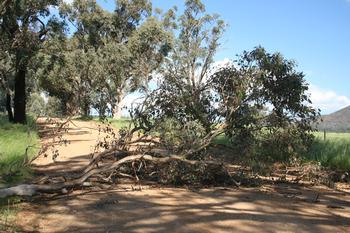 |
By the time we reach Katoomba even Toto would recognize that we're clearly back in Kansas. We're on a highway, there are exit ramps, we're in a line of traffic, and most dramatically, we're clearly into some serious hills. The exit for Katoomba takes a couple of viscous switchbacks to lose height off the highway and then drop us into town. We cruise down the high street and stop at the first hotel with a vacancy sign (we want to be able to walk to dinner). We check in, change, and head out to eat.
The receptionist said there were plenty of options, and we'd already noted a fish and chip place on our way through. We order fish and chips, then on finding it will take 10 minutes, we head back out again in search of beer. At the other end of the high street is a pub with a built-in bottle shop. We'd planned to stop for a couple, but now with our food waiting, we need to just grab some supplies and return. We were probably more than ten minutes, but we were not more than fifteen, yet we can't find the chippy. It's too simple a route for us to have genuinely lost it—we merely walked up and down the same street—so we just keep walking, but I walk right by it before realizing that they haven't moved, they have closed. All the lights are off, but the door is still open. The bloody 8pm rule works even here, a thriving metropolis less than 100 miles from Sydney? "No worries mates, your tucker's in the warmer." So we grab the bags and head back to our hotel room, which conveniently has a little kitchen area with a table and chairs. Not the best we've had, but at that point we're feeling pretty grateful to get anything. By the time we've dealt with the beers the idea of traversing the entire length of the high street again is too much, so we get an early night, which is a good thing because tomorrow morning I too have to get a dawn start. |














